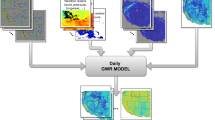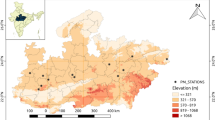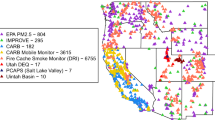Abstract
Numerous studies have demonstrated that fine particulate matter (PM2.5, particles smaller than 2.5 μm in aerodynamic diameter) is associated with adverse health outcomes. The use of ground monitoring stations of PM2.5 to assess personal exposure, however, induces measurement error. Land-use regression provides spatially resolved predictions but land-use terms do not vary temporally. Meanwhile, the advent of satellite-retrieved aerosol optical depth (AOD) products have made possible to predict the spatial and temporal patterns of PM2.5 exposures. In this paper, we used AOD data with other PM2.5 variables, such as meteorological variables, land-use regression, and spatial smoothing to predict daily concentrations of PM2.5 at a 1-km2 resolution of the Southeastern United States including the seven states of Georgia, North Carolina, South Carolina, Alabama, Tennessee, Mississippi, and Florida for the years from 2003 to 2011. We divided the study area into three regions and applied separate mixed-effect models to calibrate AOD using ground PM2.5 measurements and other spatiotemporal predictors. Using 10-fold cross-validation, we obtained out of sample R2 values of 0.77, 0.81, and 0.70 with the square root of the mean squared prediction errors of 2.89, 2.51, and 2.82 μg/m3 for regions 1, 2, and 3, respectively. The slopes of the relationships between predicted PM2.5 and held out measurements were approximately 1 indicating no bias between the observed and modeled PM2.5 concentrations. Predictions can be used in epidemiological studies investigating the effects of both acute and chronic exposures to PM2.5. Our model results will also extend the existing studies on PM2.5 which have mostly focused on urban areas because of the paucity of monitors in rural areas.
This is a preview of subscription content, access via your institution
Access options
Subscribe to this journal
Receive 6 print issues and online access
$259.00 per year
only $43.17 per issue
Buy this article
- Purchase on Springer Link
- Instant access to full article PDF
Prices may be subject to local taxes which are calculated during checkout




Similar content being viewed by others
References
Dockery DW, Pope CA, Xu X, Spengler JD, Ware JH, Fay ME et al. An association between air pollution and mortality in six U.S. cities. N Engl J Med 1993; 329: 1753–1759.
Pope CA, 3rd . Epidemiology of fine particulate air pollution and human health: biologic mechanisms and who's at risk? Environ Health Perspect 2000; 108: 713–723.
Pope CA, 3rd, Burnett RT, Thun MJ, Calle EE, Krewski D, Ito K et al. Lung cancer, cardiopulmonary mortality, and long-term exposure to fine particulate air pollution. JAMA 2002; 287: 1132–1141.
Barnett AG, Williams GM, Schwartz J, Best TL, Neller AH, Petroeschevsky AL et al. The effects of air pollution on hospitalizations for cardiovascular disease in elderly people in Australian and New Zealand cities. Environ Health Perspect 2006; 114: 1018–1023.
Rhomberg LR, Chandalia JK, Long CM, Goodman JE . Measurement error in environmental epidemiology and the shape of exposure-response curves. Crit Rev Toxicol 2011; 41: 651–671.
Armstrong BG . Effect of measurement error on epidemiological studies of environmental and occupational exposures. Occup Environ Med 1998; 55: 651–656.
Goldman GT, Mulholland JA, Russell AG, Strickland MJ, Klein M, Waller LA et al. Impact of exposure measurement error in air pollution epidemiology: effect of error type in time-series studies. Environ Health 2011; 10: 61.
Ryan PH, LeMasters GK . A review of land-use regression models for characterizing intraurban air pollution exposure. Inhal Toxicol 2007; 19: 127–133.
de Hoogh K, Wang M, Adam M, Badaloni C, Beelen R, Birk M et al. Development of land use regression models for particle composition in twenty study areas in Europe. Environ Sci Technol 2013; 47: 5778–5786.
Beckerman BS, Jerrett M, Martin RV, van Donkelaar A, Ross Z, Burnett RT . Application of the deletion/substitution/addition algorithm to selecting land use regression models for interpolating air pollution measurements in California. Atmos Environ 2013; 77: 172–177.
Wang R, Henderson SB, Sbihi H, Allen RW, Brauer M . Temporal stability of land use regression models for traffic-related air pollution. Atmos Environ 2013; 64: 312–319.
Whitworth KW, Symanski E, Lai D, Coker AL . Kriged and modeled ambient air levels of benzene in an urban environment: an exposure assessment study. Environ Health 2011; 10: 21.
Kloog I, Koutrakis P, Coull BA, Lee HJ, Schwartz J . Assessing temporally and spatially resolved PM2.5 exposures for epidemiological studies using satellite aerosol optical depth measurements. Atmos Environ 2011; 45: 6267–6275.
Alston EJ, Sokolik IN, Kalashnikova OV . Characterization of atmospheric aerosol in the US Southeast from ground- and space-based measurements over the past decade. Atmos Meas Tech 2012; 5: 1667–1682.
Lyapustin A, Wang Y, Laszlo I, Kahn R, Korkin S, Remer R et al. Multiangle implementation of atmospheric correction (MAIAC): 2. Aerosol algorithm. J Geophys Res 2011; 116: D03211.
Lee HJ, Liu Y, Coull BA, Schwartz J, Koutrakis P . A novel calibration approach of MODIS AOD data to predict PM$_2.5$ concentrations. Atmos Chem Phys 2011; 11: 7991–8002.
Jin S, Yang L, Danielson P, Homer C, Fry J, Xian G . A comprehensive change detection method for updating the National Land Cover Database to circa 2011. Remote Sens Environ 2013; 132: 159–175.
Li X, Xia X, Wang S, Mao J, Liu Y . Validation of MODIS and deep blue aerosol optical depth retrievals in an arid/semi-arid region of northwest China. Particuology 2012; 10: 132–139.
Hu X, Waller LA, Lyapustin A, Wang Y, Al-Hamdan MZ, Crosson WL et al. Estimating ground-level PM2.5 concentrations in the Southeastern United States using MAIAC AOD retrievals and a two-stage model. Remote Sens Environ 2014; 140: 220–232.
Hu X, Waller LA, Lyapustin A, Wang Y, Liu Y . 10-year spatial and temporal trends of PM$_2.5$ concentrations in the southeastern US estimated using high-resolution satellite data. Atmos Chem Phys 2014; 14: 6301–6314.
Hu X, Waller LA, Al-Hamdan MZ, Crosson WL, Estes MG, Jr, Estes SM et al. Estimating ground-level PM2.5 concentrations in the southeastern U.S. using geographically weighted regression. Environ Res 2013; 121: 1–10.
Author information
Authors and Affiliations
Corresponding author
Ethics declarations
Competing interests
The authors declare no conflict of interest.
Rights and permissions
About this article
Cite this article
Lee, M., Kloog, I., Chudnovsky, A. et al. Spatiotemporal prediction of fine particulate matter using high-resolution satellite images in the Southeastern US 2003–2011. J Expo Sci Environ Epidemiol 26, 377–384 (2016). https://doi.org/10.1038/jes.2015.41
Received:
Revised:
Accepted:
Published:
Issue Date:
DOI: https://doi.org/10.1038/jes.2015.41
Keywords
This article is cited by
-
Satellite-based prediction of surface dust mass concentration in southeastern Iran using an intelligent approach
Stochastic Environmental Research and Risk Assessment (2023)
-
A review on the application of the exposome paradigm to unveil the environmental determinants of age-related diseases
Human Genomics (2022)
-
Temporal and spatial distribution mapping of particulate matter in southwest of Iran using remote sensing, GIS, and statistical techniques
Air Quality, Atmosphere & Health (2022)
-
Spatiotemporal high-resolution prediction and mapping: methodology and application to dengue disease
Journal of Geographical Systems (2022)
-
Acute effect of fine particulate matter on mortality in three Southeastern states from 2007–2011
Journal of Exposure Science & Environmental Epidemiology (2016)



